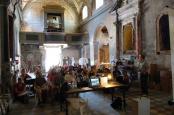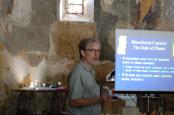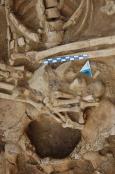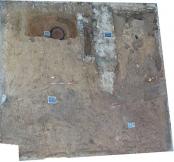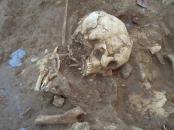CAMPAGNA 2012 |
1° SETTIMANA |
2° SETTIMANA |
3° SETTIMANA |
4° SETTIMANA |
5° SETTIMANA |
6° SETTIMANA |
19 LUGLIO 2012 
Resoconto della giornata di scavo
Area 1000
Nella giornata di oggi è stato aperto una saggio stratigrafico nella porzione Ovest dell’area di scavo, all’incrocio fra la struttura muraria US 1008 e il transetto Nord della chiesa. Il saggio misura 2x2 metri e avrà la funzione di chiarificare la situazione stratigrafica dell’area e il rapporto fra le strutture murarie intercettate dall’indagine. Nel frattempo continua lo scavo nella pozione Nord-Est dell’area che ha messo completamente in evidenza la struttura muraria US 1018.
Today in area 1000, the wall in the Northeast
corner was uncovered and continued to the Eastern perimeter. A long and narrow
trench running alongside it was also cleaned out. It was comprised of a number
of modern materials including glass, pottery, and bricks. The area was then
cleaned and sketched. A new section was also established in the Southwest
corner of the area around the ossuary. The new area 1500 was outlined and
defined to form a square pit. The goal in creating the new area is to
investigate the foundations of the 16-17th century wall running along the
Southern perimeter of area 1000 as well as the foundation of the transept. Area
1500 is being used as a stratigraphic control pit for area 1000 as a whole.
Area 2000
L’Us 2034 è stata completamente messa in luce e risulta una delle sepolture tra le più interessanti rinvenute sia per la tipologia che per l’ottima conservazione delle ossa in connessione. L’individuo, un maschio adulto orientato Est-Ovest, è posto supino, con il cranio lievemente ruotato verso destra, le braccia piegate sull’addome e diversi grani di rosario intrecciati tra le mani, le gambe distese e parallele. Durante lo scavo è stato identificato un sottile strato carbonioso disposto omogeneamente sulla metà ovest del fondo; questo dettaglio, unito alle osservazioni tafonomiche effettuate in corso di scavo, fanno pensare alla presenza di una tavola posta sopra e sotto la metà superiore del corpo dell’individuo. Si ricorda che al di sopra era stata collocata una riduzione di ossa, appartenente ad un individuo probabilmente intercettato prima della deposizione di Us 2034. All’interno della vasca laterizia continua la messa in luce di Us 2237 (avente anch’esso una riduzione collocata nei pressi del bacino), di cui ad ora risultano visibili il cranio, gli arti superiori incrociati sul bacino e gli emitoraci. Come corredo è stato rinvenuto un gancetto metallico vicino alle vertebre toraciche e alcuni grani di rosario presso le mani.
As usual the group remained split into several
groups and some individuals worked on projects by themselves. Claire worked on
her own excavation pit today starting with filling out three context sheets
from the previous day of excavation. The context sheets were for cuts, -2239,
-2232, and fill 2233. After the sheets were completed she worked on excavating
a new cut 2231 which contained several interesting artifacts in its fill. She
found several skull and vertebrae fragments as well as two beads and a very
interesting medallion depicting a cross and Maria of Loreto. Veronica worked by
herself today by starting to remove a disconnected skull and os coxa which lay
on top of a more complete skeleton in the north section of area 2000 west of
the brick wall. After removing the disconnected fragments she proceeded to
clean and expose the top half of the skeleton underneath including the skull,
clavicles, parts of some ribs, the humerus and some of the scapula. Molly and
Alexa continued to work on skeleton 2234 to finish fully exposing the skeleton
so it could be photographed and mapped out for GIS. The skeleton was fully
articulated missing only a left patella, also very interesting was the skeleton
seemed to be holding a rosary in its left hand, with both arms flexed crossing
over its abdomen. When the had fully uncovered the skeleton it was cleaned by
brush and prepped for photos to make a 3D recreation of the burial and points
were measured to be used to map the burial out on GIS. Adam and Walker worked
in separate labs today, Adam working in the Bone lab while Walker worked in the
material culture lab. Adam spent his first day in the bone lab cleaning the
bones of a skeleton to prep it for diagnostics tomorrow. Walker started the
first part of the day cleaning the rest of fill 2205 which contained nothing of
interest before being going to the material culture lab. Their he worked on
cleaning pieces of pottery and saw how some of the medallion restoration was
done. He also worked on labeling fragments of pottery with a quill pen which
finished the days work.
Area 3000
Nella giornata di oggi si è proceduto alla documentazione e rimozione dell’individuo US 3184, deposto in decubito supino ed in pessimo stato di conservazione. Lo scheletro risulta tagliato in corrispondenza del torace ed inoltre le ossa sono schiacciate verso il basso, probabilmente dalla pressione esercitata dalla terra e dal calpestio continuo. Nel Settore B, oltre ad aver portato a termine lo scavo della riduzione US 3180, in particolare del cranio ben preservato, è stata individuata una nuova sepoltura ( US 3187), ancora in corso di scavo, deposta in decubito dorsale ed orientata N-S, nella porzione S-W dell’area. Per il momento sono stati messi in luce solamente gli arti inferiori, simmetrici e distesi e da una prima analisi sembrerebbe trattarsi di un individuo subadulto, in buono stato di conservazione, contestualizzabile alle fasi cimiteriali del XVIII-XVII secolo. Prosegue inoltre la messa in evidenza verso ovest del muro medievale della chiesa abbaziale, la cui porzione occidentale risulta aver subito alcuni interventi di asportazione, probabilmente legati al recupero di materiale litico più pregiato appartenente al paramento murario.
Today, Heather, Amanda, and Emilia worked to
remove the skull from the southern portion of the area. Amanda when to work in
ceramics after Dr. Larsen’s lecture. Meanwhile, Heather, Emilia, and Michael
removed the skull. Heather and Emilia continued troweling towards the north of
the burial to see if they could discover any more of the skeleton that was
underneath the skull. Frank and Emma filled on the context sheet from the
previous day’s excavations. They then worked to uncover a sub-adult skeleton in
the southern portion of the area that was oriented North/South. So far they
have uncovered the entirety of both legs and part of the pelvis. The skill us
missing, and appears to have been cut by the wall. Michael continued his work
to uncover the Western portion of the lythic tomb. The area is being thoroughly
cleaned for a photograph tomorrow. The upper bounds will be removed, so that
the floor of the tomb can be uncovered. Leti has now fully uncovered the
medieval wall and found a small cross in the area.
Area 4000
È proseguita, nella giornata di oggi, la rimozione dei contesti stratigrafici relativi alle fasi cantierali di XIX sec. Questo ha consentito la messa in luce dei tagli UUSS -4083, -4082, -4078 e -4073. I primi due sembrano testimoniare l’azione di una installazione di pali inseriti in fosse ben più larghe del loro diametro e solo dopo colmate di calce e materiale lapideo. Gli altri due taglio si riferiscono a quelle che sono state ipotizzate, nei giorni scorsi, come fosse per lo spegnimento della calce; una volta rimosso lo strato di materiale calcaroso accumulatosi sul fondo è stato possibile definire diametri, profondità e superfici di entrambe le due fosse calcare. Inizia così, nella seconda parte della giornata, la rimozione di US 4071 (lo strato relativi ad azioni di distruzione presente nella fascia settentrionale dell’area e che dovrebbe insistere, da paragone con l’adiacente settore A, sul contesto US 4064, indagato nella precedente campagna di scavo e composto da lastre di ardesia risultanti da un crollo e successivamente spianate ad un livello orizzontale) e di US 4070 ( lo strato presente nella zona sud-orientale dell’area, relativo ai livelli humotici più alti del saggio, particolarmente danneggiato dall’insistenza, su di esso, di una fitta vegetazione).
Today (July 19) in Area 4000, we removed the fill from two pits (cuts -4083 and -4082) and removed the mortar from two other pits (cuts -4078 and -4073). While removing the fill from -4082, we found two pieces of rectangular marble tile, a material we had not previously found in our area. In the post hole pit of -4083, we found many shards of wood from a pole; this pit is also interesting because it slopes toward the well. In -4078, we found yellow soil which indicates that a heat source has been there. We photographed all four areas and began pickaxing the destruction layer of brick and slate.








